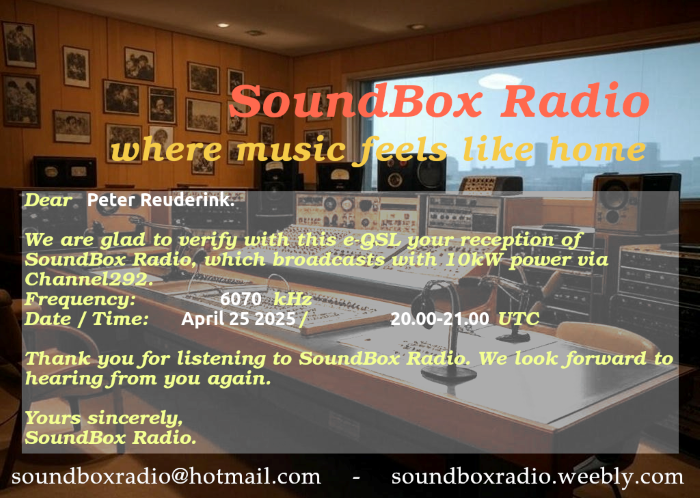
A program I hadn’t heard before on Channel 292, Germany is SoundBox Radio. On Friday night they broadcast a nice mix of Disco music on 6070 kHz. My reception report was awarded with an e-QSL and a friendly email in a day.
"It's not true I had nothing on, I had the radio on" - Marilyn Monroe

A program I hadn’t heard before on Channel 292, Germany is SoundBox Radio. On Friday night they broadcast a nice mix of Disco music on 6070 kHz. My reception report was awarded with an e-QSL and a friendly email in a day.

Last weekend Key Channel Radio, broadcasting from Emilia Romagna, Italy, was on air on 6270 kHz. Massimo, who operates the station was so kind to give me a heads up warning. Reception wasn’t easy as propagation conditions were poor and there was quite a bit of noise/interference which required them to change frequency a few times.
Massimo sent me the beautiful e QSL, a friendly email and some photo’s of the stunning scenery in Emilia Romagna:
Dear Peter, thanks for your valuable listening report. In the end you listened to us too. Tough evening, stanag, CW all active. Yes we changed the frequency 4 times.
KCR has been broadcasting since January 2016 from a location on the hills of the Emilian Apennines.
We use a commercial transmitter with a maximum power of 400 W (in use 250 W) and a self-built Morgain 48/88 Antenna.
There are three of us who manage it, I take care of the technical part, programs.
My girlfriend takes care of important statistics on listeners and small studies on propagation. A dear friend of ours takes care of the graphics, the promos and QSLs are her creations.
We are an open radio, we have collaborated with several German Pirate Radios, Doctor Tim, Radio BZN and more. Now we collaborate with Radio Monique, Bart even made a broadcast and several Jingles for us. (Pirate for Peace Member).

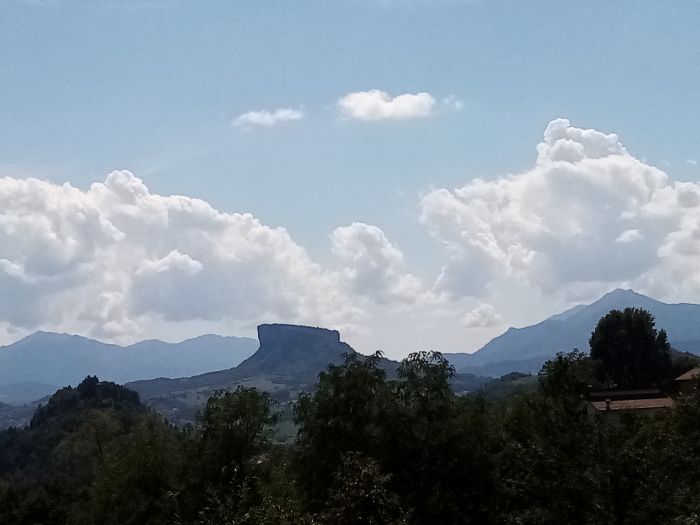
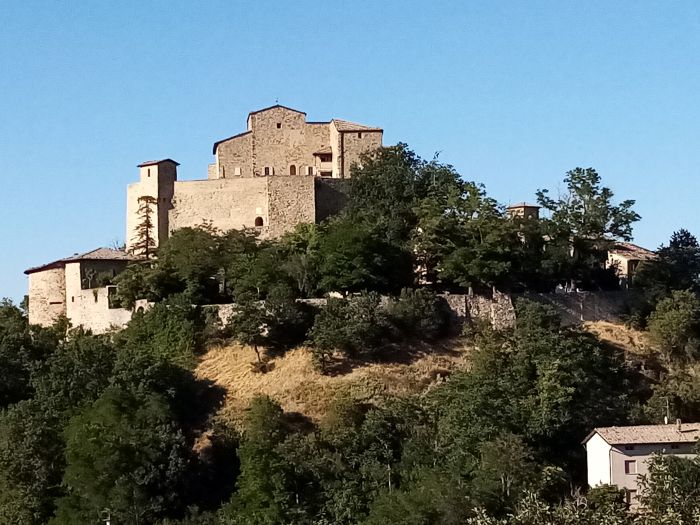
.
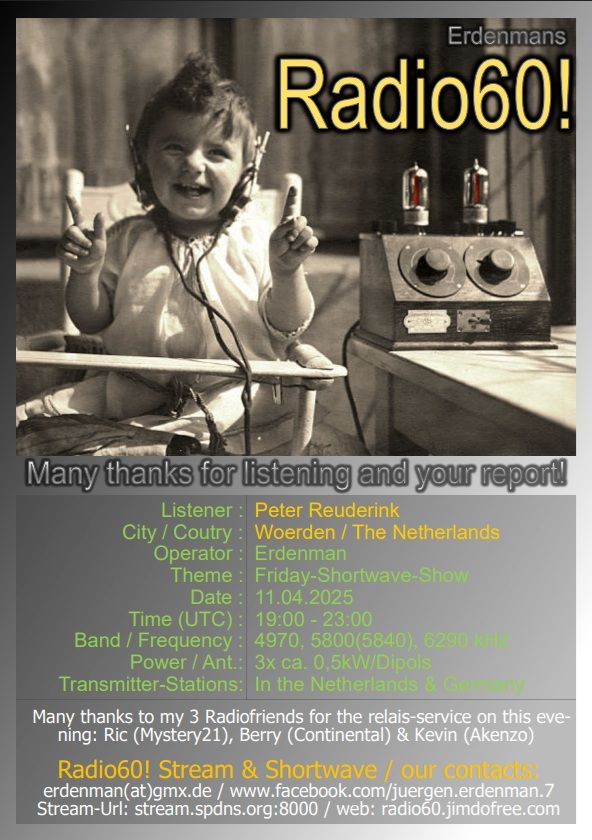
Last weekend I received Radio60! in good quality on 5840 kHz. Most likely via the transmitter of the Dutch free radio station Contikenzo.
The program was presented by Jürgen who is known as Erden Man in the Free Radio world. He sent me this beautifully designed e-QSL via erdeman(at)gmx.de . Thank you Jürgen!
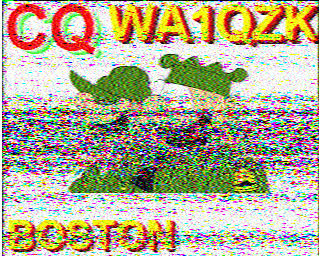

I’m not so much into HAM radio. Not that I have anything against HAMs – on the contrary – but there is already so much to listen to that I decided not to go there yet. If I’m going to do HAM I want to be able to transmit myself.
That said, I’ve found SSTV always attractive. And particularly when MF conditions aren’t great I don’t mind “sacrificing” one of my DSC receivers scanning 14230 kHz (or another HF SSTV channel). This way I picked up WA1QZK from Boston.
Intercontinental DX is always nice. Problem is that as an SWL (even when registered with VERON) you don’t always have access to email address information in a database like QRZ.com. But Ron, operator of WA1QKZ was so kind to share his email with SWLs as well, so I sent a report… and received the QSL card below. Thank you Ron!
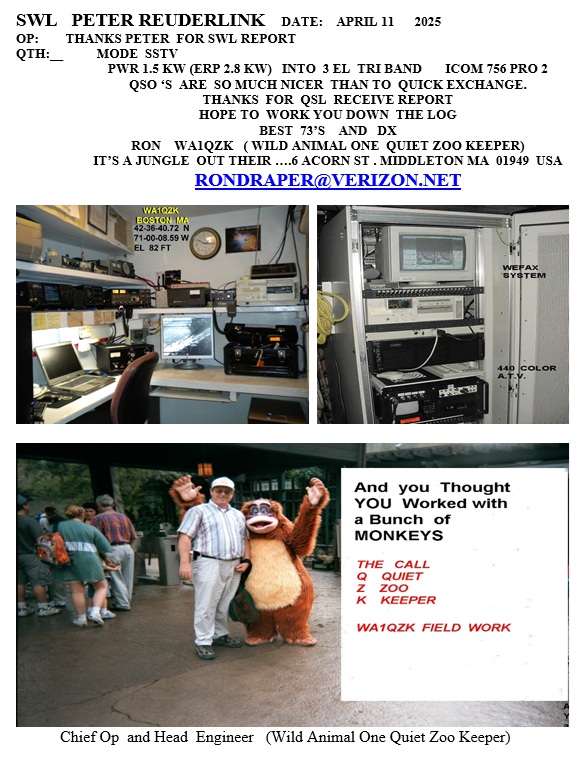
Pheww.. this one was a little bit tense… Already 5 days ago I got an email prompt (a scan of the card) indicating that my QSL from NHK had arrived in the Netherlands. That’s how the Dutch Postal Service works which is great, but apparently it still took them 5 days to deliver my card. In the mean time I was wondering if they delivered it to the wrong address.

Normally I wouldn’t have mind so such, but this was the last chance to get a traditional NHK QSL… Fortunately, today I found it in my mailbox.
I feel a little bit sad about this one, and I’m angry as well. Running a shortwave radio station requires a million dollar budget, but it also requires qualified technical personnel. So sending out a few QSLs per year to people that have a true technical interestest in your station doesn’t seem a bad idea… The “Finance Dudes” seem to have different perspective. Anyway, it is what it is… and this one goes on file. Thank you NHK for all the years that you did grant dedicated listeners a QSL!
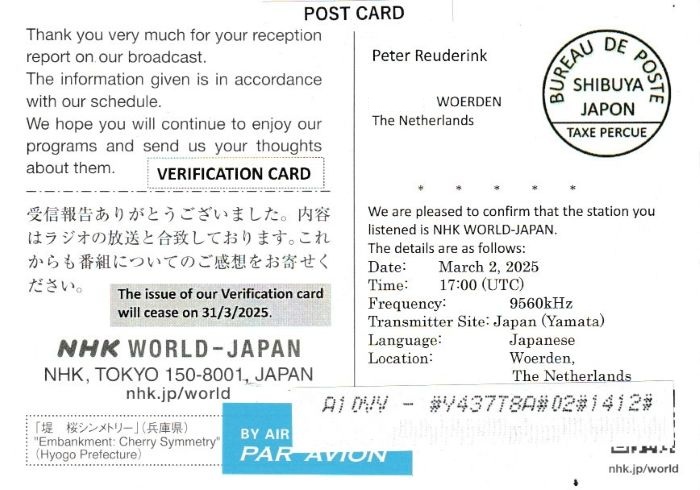
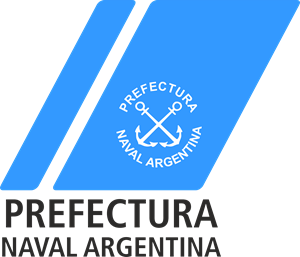
I received Comodoro Rivadavia Radio with a DSC test acknowledgement to a vessel with MMSI 311000867 (SYLVIA EARLE, Bahamas). It’s the second time I sent them a report. I heard them earlier in December 2024. They confirmed they were sending a message at the time but my decode of the MMSI of the ship they contacted was incorrect. Despite the ERR check being OK. These things can happen sometimes. This time there was one other DX-er that picked up the same message using YADD decoder, so I was confident I really heard them!
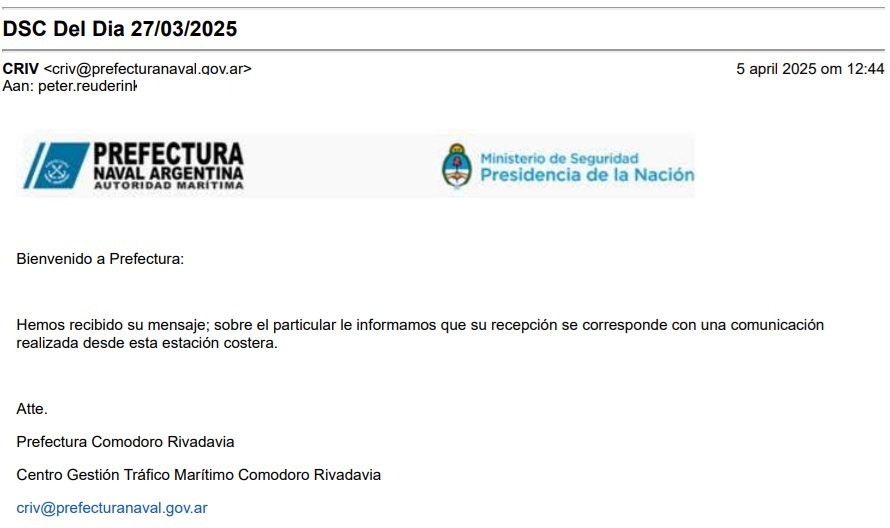
The distance between my QTH and Comodoro Rivadavia is 12890 kilometers… and this is definitely not a DSC station that I hear as often as the ones from Brazil. My other confirmation from Argentina was Buenos Aires Radio.

A nice paper QSL from Radio Slovakia International. I received them on 6005 kHz via the Kall-Krekel transmitter in Germany. Unfortunately that detail is missing on the card. I sent my report to englishsection@rtvs.sk and got a reply in 6 weeks.
Their latest schedule can be found here: https://enrsi.stvr.sk/how-to-listen
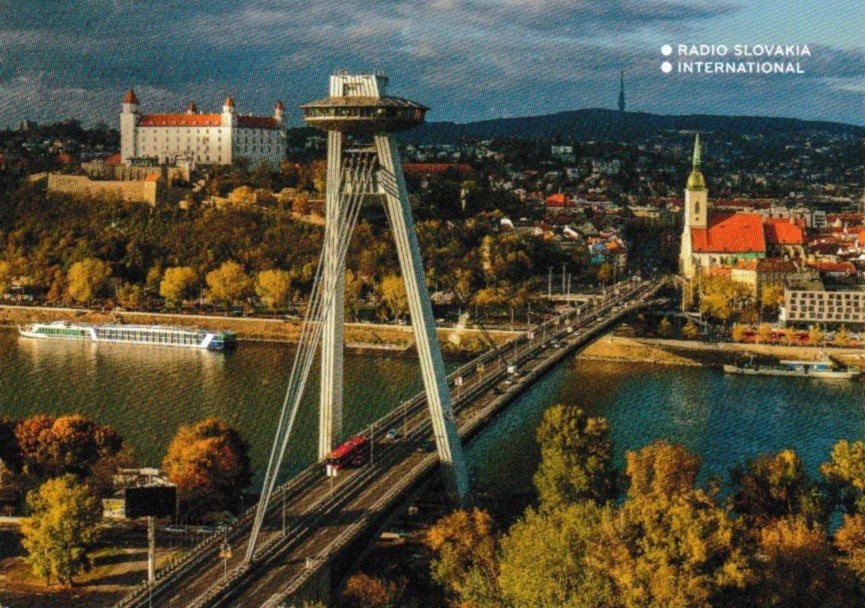
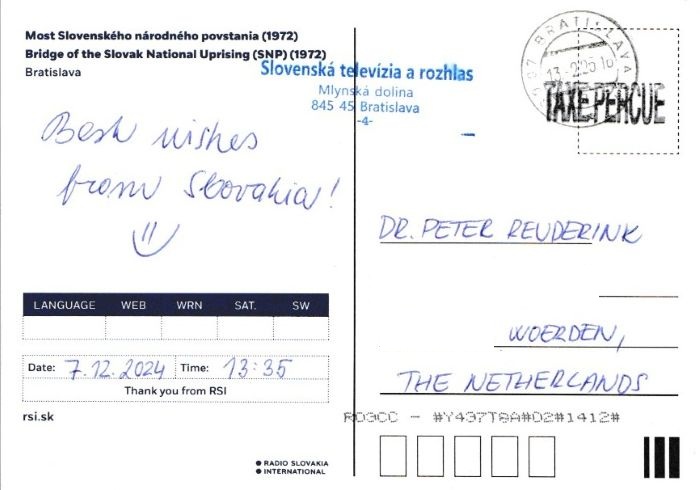
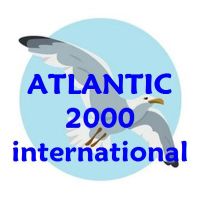
I like to listen to Atlantic 2000 International because of their choice of music. Their opening tune “warms the heart”. So I sent them another reception report and as always I got a beautiful QSL in return:
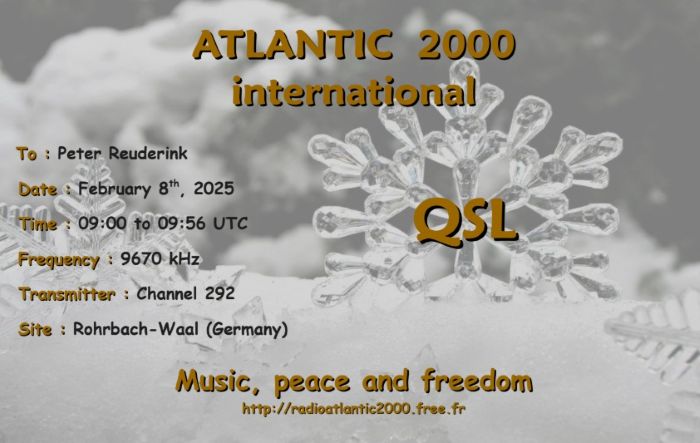

The Moosbrunn shortwave antenna is no more. In August last year I still received a QSL email for the Ö1 program on 6155 kHz. Utilization of the Moosbrunn transmitters had gone down for years, until there was only a 75 minute broadcast left. But following the Russian invasion in the Ukraine the number of broadcasts went up with daily morning, afternoon, and evening programs. With global tensions rising the decision to destroy the Moosbrunn facilities is not without controversy. Last week a petition was started to reconsider. But with what seemed apparent haste, the antennas were blown up…
Below a picture of the antenna when it was still operational. It was basically an array of dipoles in front of a curtain reflector. The whole ensemble could be rotated to give the beam the desired direction.

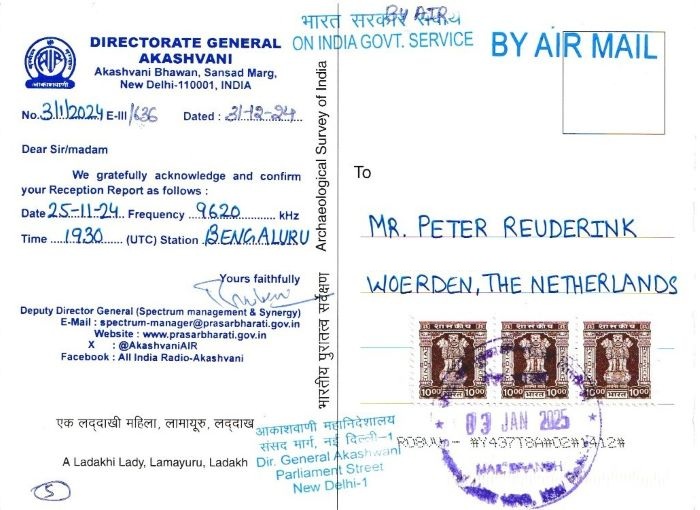
Akashvani or All India Radio is another broadcaster that still issues nice paper QSL cards. I sent my reception report on their program in French to spectrum-manager@prasarbharati.gov.in . Seven weeks later this beautiful card was delivered.
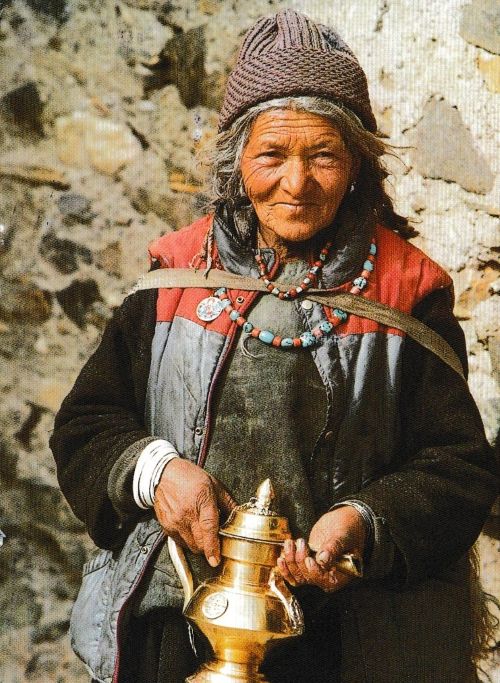
© 2025 Peter's DX Corner
Theme by Anders Noren — Up ↑